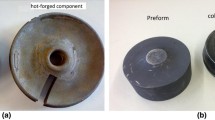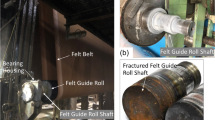Abstract
This study deals with the analysis of an ink-producing machine rotor part composed of WC–2Ni–1Co which failed in brittle manner during service. The part was made by powder metallurgy techniques and is being used in ink-grinding machines due to its high hardness and wear resistance. Similar parts had worked satisfactorily for many ink compositions, but the part under investigation failed prematurely. Investigation was considered important because the part is expensive, and other identical components frequently failed after a short service life. Moreover, replacement of the part requires complete dismantling of the machine which reduces the production rate. Spectroscopic analysis, density, optical and scanning electron microscopy, SEM–EDS analysis, fractography, X-ray diffraction, and microhardness measurements were carried out on failed parts to find out the root causes of the failure. Results revealed that the part cracked due to combined effects of selective dissolution of metal binder-caused corrosive action of ink solution and hydrogen-induced deterioration of WC and Ni–Co phases. Localized removal of binder phase left the hard WC phase unsupported. Cracks were found initiating from the root of the machined slot which acted as a stress concentration point and resulted in brittle fracture.








Similar content being viewed by others
References
Park, Y.J., Hwang, N.M., Yoon, D.Y.: Abnormal growth of faceted WC grains in a Co liquid matrix. Metall. Trans. A 27, 2809 (1996)
Chabretou, V., Allibert, C.H., Missiaen, J.M.: Quantitative analysis of the effect of the binder phase composition on grain growth in WC–Co sintered materials. J. Mater. Sci. 38(12), 2581–2590 (2003)
Humail, I.S., Akhtar, F., Askari, S.J., Tufail, M., Qu, X.: Tensile behavior change depending on the varying tungsten content of W–Ni–Fe alloys. Int. J. Refract. Met. H 25, 380–385 (2007)
Larsen-Basse, J.: Effect of composition, microstructure and service conditions on the wear of cemented carbides. J. Met. 35(11), 35–41 (1983)
Brookes, K.J.A.: World Directory and Handbook of Hard Metals and Hard Materials, 6th edn. International Carbide Data (1996)
Almond, E.A.: Proceedings of the International Conference on the Science of Hard Materials, p. 527. Plenum Press, New York (1981)
Li, C.J., Ohmori, A., Harada, Y.: Effect of powder structure on the structure of thermally sprayed WC–Co coatings. J. Mater. Sci. 31, 785–794 (1996)
Kurlov, A.S., Rempel, A.A.: Effect of sintering temperature on the phase composition and microhardness of WC–8 wt%Co cemented carbide. Inorg. Mater. 43(6), 602–607 (2007)
Ettmayer, P., Lengauer, W.: Carbides: Transition Metal Solid State Chemistry Encyclopedia of Inorganic Chemistry. John Wiley & Sons (1994). ISBN 0471936200
Pollock, C.B., Stadelmaier, H.H.: The eta carbides in the Fe–W–C and Co–W–C systems. Metall. Trans. 1(4), 767–770 (1970)
Lunarska, E., Zaborski, St.: Hydrogen effects in anodic grinding of Ti alloy. Wear 249(7), 606–616 (2001)
Kolachev, B.A., Tatalaev, V.D., Egorova, B.Y., Kravchenko, A.N.: Influence of hydrogen on the process of cutting of VT5-1 titanium alloy. Fiz.-Khim. Mekh. Mater. 32(6), 107–112 (1996). [English Translation]
Pacechnik, A.A., Tsyrul’nyk, O.T., Provors’kyi, I.M.: Influence of electrolytic hydrogenation on the process of cutting of carbon steels. Fiz.-Khim. Mekh. Mater. 33(4), 139–144 (1997). [English Translation]
Bassarab, I., Bilyk, N.V., Chernyakhivs’kyi, L.Y.: Influence of the procedure of hydrogenation on the electrochemical and mechanical properties of WC–Co hard alloys. Mater. Sci. 37(1), 137–139 (2001)
Perry, J.M., Neville, A., Hodgkiess, T.: A comparison of the corrosion behavior of WC–Co–Cr and WC–Co HVOF thermally sprayed coatings by in situ atomic force microscopy (AFM). J. Therm. Spray Technol. 11(4), 536–541 (2002)
Vasyliv, B., Ivasyshyn, A., Ostash, O.: Effect of corrosion environment on the fatigue behavior of WC–Co hard alloy teeth of drill bits. In: Innovative Superhard Materials and Sustainable Coatings for Advanced Manufacturing, vol. 200, pp. 469–475. NATO Science Series (2005). doi:10.1007/1-4020-3471-7
Milman, Y.V., Lucykx, S., Northrop, I.T.: Influence of temperature, grain size and cobalt content on the hardness of WC–Co alloys. Int. J. Refract. Met. H 17, 39–44 (1999)
Exner, H.E.: Physical and chemical nature of cemented carbide. Int Met. 24, 149–173 (1979)
Vasel, C.H., Krawitz, A.D., Drake, E.F., Kenik, E.A.: Binder deformation in WC–(Co, Ni) cemented carbide composites. Metall. Mater. Trans. A. 16(12), 2309–2317 (1985)
Brookes, K.J.A.: World Directory and Handbook of Hardmetals, 4th edn. International Carbide Data (1987)
Barchan, A., Vasyliv, B.: Effect of pH level on electrochemical behavior and corrosion fatigue of WC–Co hard alloy. In: Fracture Mechanics Beyond 2000, vol. I/III. EMAS Publishing (2002)
Lunarska, E., Zaborski, S.: Role of hydrogen in the efficiency of anodic grinding of WC–Co sintered alloy. Mater. Sci. 37(4), 551–558 (2001)
Batrakov, V.V.: Handbook on Corrosion of Structural Materials: Gases and Inorganic Acids, vol. 1. Metallurgiya, Moscow (1990). [English Translation]
Vasyliv, B.D., Bassarab, A.I., Ivasyshyn, A.D.: On the mechanical and corrosion aspects of the formation of operational characteristics of tungsten-cobalt hard alloys. In Proc. 4th Int. Syrup. Ukr. Mech. Eng., pp. 125–126 (1999). [English Translation]
Acknowledgments
The authors thank Mr. Sajid Ali Asghar for XRF analysis, and Mr. Zahid of Materials Engineering Department for optical microscopy. The authors also thank Mr. Yousuf Khan (Centralize Science Laboratory, Karachi University) for providing SEM–EDS facility, and Mr. Sheikh Kamal-ud-din (PCSIR Laboratories, Karachi) for providing XRD facility.
Author information
Authors and Affiliations
Corresponding author
Rights and permissions
About this article
Cite this article
Faraz, M., Tariq, F., Ali, A. et al. Failure Analysis of WC–2Ni–1Co Rotor Part. J Fail. Anal. and Preven. 10, 312–321 (2010). https://doi.org/10.1007/s11668-010-9358-3
Received:
Published:
Issue Date:
DOI: https://doi.org/10.1007/s11668-010-9358-3




